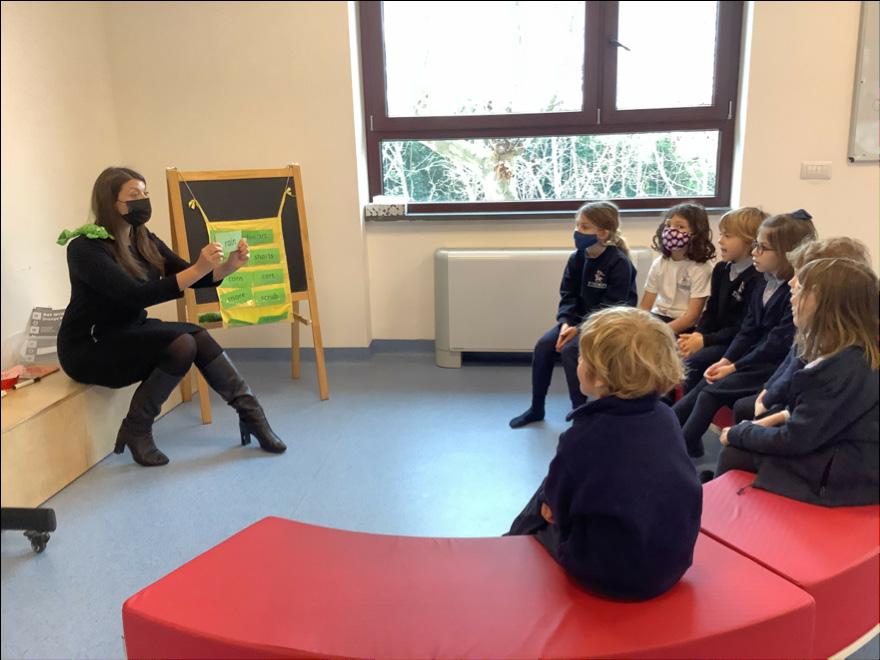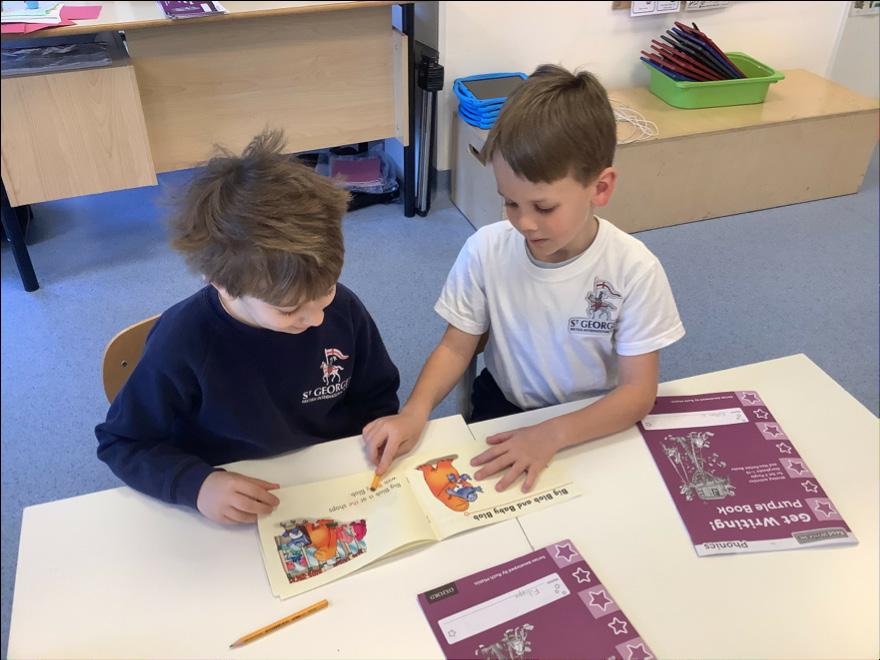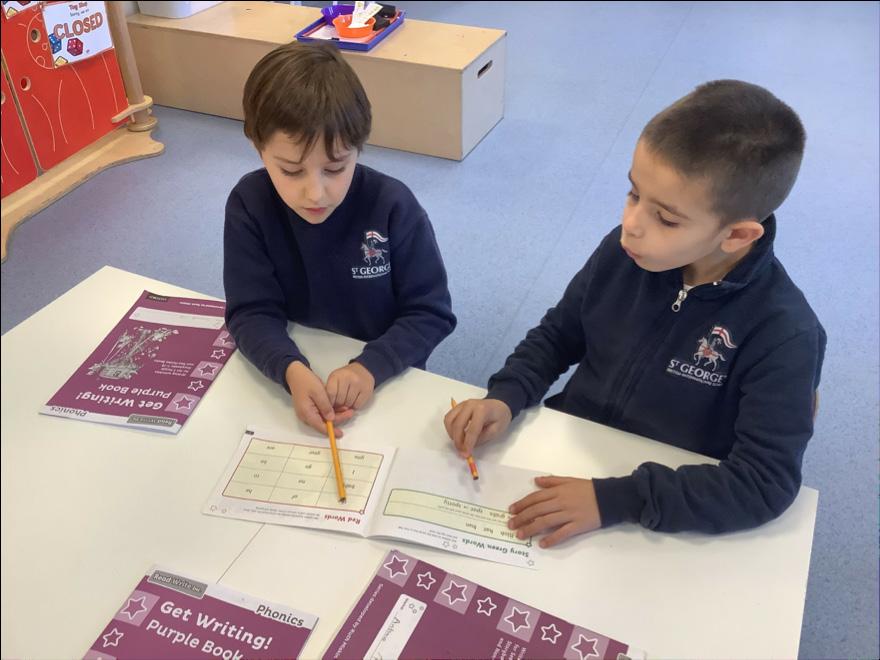
10 minute read
How we used John Kotter’s 8-step change model to implement the ReadWriteInc phonics programme at St George’s City Centre
Sarah Knights
Deputy Head of City Centre Junior School
Advertisement
Through the implementation of a robust phonics programme, ReadWriteInc, predominantly for Green Dragons to Year 2, we aim to significantly increase attainment in writing across the school over a period of time, whilst also supporting the needs of our children with English as an additional language and the demands that this can place on the delivery of the English National Curriculum.
The implementation of this intervention was based on John Kotter’s ‘8 Step Change Model’.
Step 1 - Establishing a sense of urgency
The first step highlights the importance of building a sense of urgency. Raising the level of urgency and creating an enthusiasm for change was achieved by exposing the following ‘weaknesses’, and as a result, creating the necessary change drivers: 1. In the year 2018-19, the introduction of an online comparative judgement writing assessment tool (developed by Daisy Christodoulou) for Years 1 - 6, indicated that many of our children were working at below age expectations.
2. Although phonics, writing, guided reading, spelling and handwriting were all being taught discretely in EYFS and KS1, an unavoidable lack of synchrony meant that gaps in understanding were emerging.
3. Limitations of the timetable did not allow for delivery of a comprehensive phonics programme.
4. Although included within planning, a lack of differentiation, necessary to ensure rapid progress, meant that children were being taught at age expectations, as opposed to their ability. This had obvious implications for our EAL and AEN children, particularly those that joined the school at the start of Year 1, many of them not having had any previous education.

Step 2 - Creating a guiding coalition
Proposal for the Implementation of ReadWriteInc for Green Dragons, Y1 and Y2
Kotter says, ‘When a group of the right people come together in an atmosphere of trust and focused on a common goal, powerful transitions can happen.’ Having identified weaknesses in the current model, the next step was to overcome barriers to the implementation of a complete programme. Initially there was some scepticism around the practicalities of linear grouping, how the programme would be delivered successfully, with only a limited number of adults having previously received full training in ReadWriteInc, and also who would lead the programme.
Following honest discussion as to how we might achieve the change, there was greater buy-in to the model, and as a result a proposal explaining the rationale for this change in curriculum was sent to Strategy: 1. The mission of ReadWriteInc is to teach every child to read, and to keep them reading. This linked perfectly with one of our school actions - to embed a love of reading amongst our children.
2. Specialist 2-day training for all teaching staff to ensure a consistent approach throughout the school.
3. Sessions to be timetabled for 50 mins each morning, Period 1, for Green Dragons to Year 2.
4. Grouped by ‘stage’ not ‘age, children to be both supported and challenged at the right level for them. Linear grouping ensures that each child’s needs are being catered for, and enables any child starting within the academic year to join a group which best suits their ability.
5. Since each session incorporates spelling, reading, writing and handwriting, where this is currently timetabled separately, time can be spent more creatively building on the skills the children have learned.
6. Comprehensive planning provided for teachers, enabling them to channel their energy and creativity into teaching fun and engaging lessons.
7. Presentation and workshop for parents illustrating how they can be involved with their children’s reading.
Step 3 - Developing both a vision and a strategy
With the proposal agreed, we had six months to plan for the implementation of ReadWriteInc into our curriculum, the goal being to start in September 2019.
Firstly, we needed to ensure a clear, shared vision. Our overarching aim was to teach every child to read and write, learning alongside others at a similar challenge level, and as a result, increase attainment in writing across the school.
We then created a timeline of actions, in preparation for the new academic year. This included communicating the vision to the rest of the staff, arranging for whole school training in ReadWriteInc, ordering and preparation of resources, adaptation of the timetable to enable the provision of the programme at a specific time, and presenting the change to parents.
Step 4 - Communicating the vision
Communication is everything, and Kotter maintains that we need to use every means at our disposal to constantly communicate the new vision and strategies that support it. This step is very much about building trust amongst colleagues.
Regular meetings helped to ensure that actions were being completed, as well as addressing colleague’s fears and concerns with respect to the new change to the curriculum. Would the change accommodate all areas of English? How was writing going to be taught? Was a 50 minute session too long for Green Dragons? It was essential that specific people were always included in these meetings, and that they felt personally considered and listened to, ensuring ultimate buy-in.
I have always been an advocate for the Read Write Inc. Phonics programme, being fortunate enough to work in model schools in the UK and witness the accelerated progress across a range of learners. I was excited at the prospect of being part of implementing the change here at SGCC. Enabling a progamme like this is never without its hurdles, but for me these are worth overcoming when we see the progress the children make. Before we started the programme there were clear gaps in the children’s knowledge which I, as a Key Stage 1 Class Teacher, found difficult to fill on my own. Working as a team and placing our
trust in one another as professionals, means that we can feel secure in the knowledge that every child is being met at their level and are successful in their literacy journey.
Natasha Woods Year 1 Class Teacher City Centre
Step 5 - Enabling action and removal of obstacles
At this stage, Kotter explains the importance of proactive actions to remove obstacles involved in the process of change. For example:
Skills barriers In order for the programme to be delivered successfully, specific training was required. Although this came at a significant cost, it was agreed that training everyone would have greater impact than training just one or two teachers. Furthermore, staff felt valued when they were provided with specialised training, encouraging them to have greater buy-in. In August 2019 all teaching staff received ReadWriteInc training, to ensure consistent delivery throughout the year groups.
Systems barriers Inflexibility of the timetable, due to specialist teaching, meant that negotiations had to be made with colleagues to enable ReadWriteInc to be taught at the same time each day across three year groups. Addressing these areas helped to maintain positivity towards the implementation of the programme.
Step 6 - Generating short-term wins
Success breeds success. Kotter states that ‘an early taste of victory in the change process gives people a clear sight of what the realised vision will be like.’
We know that short-term wins are vital for the success of a long-term

transformation across the school, in this case, attainment in writing. One example of this was the comparative judgement writing assessment that Year 1 completed in January 2020. Although considerations must be made for the number of EAL/ AEN children, boys versus girls, etc. attainment was significantly higher compared to the previous year. However, this was only one area of improvement - regular six-weekly phonic assessments indicated accelerated progress for many children across all three year groups.
Unfortunately, this step was to be suddenly slowed down, with the onset of Covid-19. During the four months of online learning from March to June, where possible we continued with our sessions first thing in the morning, maintaining the linear grouping. However, with assessment being challenging, and many children not regularly engaging with their lessons (for many different reasons), progress slowed. On returning to school in September, further restrictions such as the compulsory wearing of masks for teachers and children in Year 2 and above, as well as social distancing, meant that our linear approach to learning could not be practiced and as a result the programme could not be executed effectively.
Step 7 - Consolidation of gains to build momentum
As Kotter says. ‘When the urgency recedes, the natural tendency is for everyone to resume defending their own area of control.’ In this case, the sense of urgency was taken out of our hands, and teaching staff had to consider the needs of their own year group as opposed to being able to look at the bigger picture. ‘The net effect of a loss of momentum, is that the overall process ends up taking far more time and energy than was really needed.’ Many children made limited progress during the lockdown period, some losing many of the skills that they had already achieved. Coupled with the fact that they could not then be taught in a group necessarily suited to their level of attainment, momentum slowed.
In order to create another short-term win, we decided to timetable an intensive programme of ReadWriteInc for one week, at the end of September 2020. In consultation with year group leaders, we decided that many of the children needed a quick boost in order to get them back on track. This proved to be very successful, and repeated assessment a week later, showed that the majority of children were back to their expected level of attainment.
I joined the school after RWI had been in operation for around one year. At this point it was very well established with clear routines, well understood methodology from all the staff and most importantly it was highly regarded and appreciated as a positive initiative.
Matthew Woodhead Head of City Centre Junior School

Conclusion: Step 8 Anchoring the change
Changes take time, and in this step Kotter describes the need for opportunities, or short-term wins, to ensure that all stakeholders stay the course. As we have become more adaptable to ‘life with Covid’ we have continued to find opportunities to plan for short-term wins, and as a result, try to embed the change.
We know that we all have a shared responsibility to identify any gaps, and areas where we can develop in the current situation. We continually share any suggestions or solutions to improvement. As a result, following assessment of Green Dragons, Y1, Y2 and a small number of Y3 children at the start of 2021, which highlighted the growing number of gaps between children, coupled with a lack of expected progress for many, we made the strategic decision to revert back to our linear grouping. With both Matt and myself also teaching, we now have eight groups, with children again learning within their ‘stage’ and not ‘age’.
Within a few weeks we are already seeing the benefits of this decision, not only from the progress that the children are making, but also the revived enthusiasm from everyone involved in the delivery of ReadWriteInc.
It is going to be very important to ensure that the ‘change’ continues throughout the next stages for the children as they move further into KS2. Being able to bring back Year 3 children, that need further consolidation, has been really beneficial and their class teachers have reported significant changes in the children’s attitude towards writing and their level of achievement in class - it will be interesting to see if this is backed up in their next Comparative Judgement activity. The advantage of having had all staff trained in RWinc means that we can continue to use the language across the year groups for any children who continue to need quick reminders about ‘simple’ and ‘complex’ sounds and we need to ensure that these children have access to the visual prompts (the Complex Sounds Chart) whenever and wherever they need it.
Jude Adams Year 2 Class Teacher & Phase Coordinator









